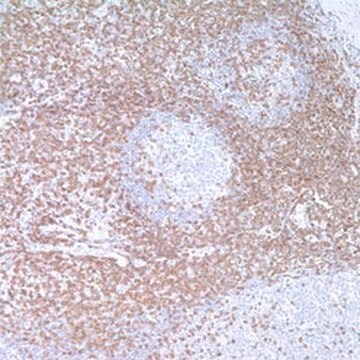Based on the information available, this version does recognize the epsilon subunit. This conclusion is drawn from the fact that the CD3 epsilon, also known as the cytoplasmic CD3 antibody, exhibits a cytoplasmic staining pattern with perinuclear Golgi accentuation and very rarely membranous. Typically, this antibody is utilized for identifying T cell and NK cell lymphomas in FFPE tissues (please refer to representative staining photos). While the Cd3 surface antibody is commonly used in flow cytometry for membranous CD3 detection, the CD3 epsilon cytoplasmic is generally used in FFPE tissue, as is often done for IHC.
103R-9
CD3 (MRQ-39) Rabbit Monoclonal Antibody
Sélectionner une taille de conditionnement
Sélectionner une taille de conditionnement
About This Item
Produits recommandés
Source biologique
rabbit
Niveau de qualité
100
500
Conjugué
unconjugated
Forme d'anticorps
culture supernatant
Type de produit anticorps
primary antibodies
Clone
MRQ-39, monoclonal
Description
For In Vitro Diagnostic Use in Select Regions (See Chart)
Forme
buffered aqueous solution
Espèces réactives
human
Conditionnement
pkg of 0.1 mL concentrate (103r-94)
pkg of 0.5 mL concentrate (103R-95)
pkg of 1.0 mL concentrate (103R-96)
pkg of 1.0 mL predilute (103R-97)
pkg of 7.0 mL predilute (103R-98)
Fabricant/nom de marque
Cell Marque®
IVD
for in vitro diagnostic use
Technique(s)
immunohistochemistry (formalin-fixed, paraffin-embedded sections): 1:100-1:500 (concentrated)
Isotype
IgG1
Contrôle
tonsil
Conditions d'expédition
wet ice
Température de stockage
2-8°C
Visualisation
membranous
Informations sur le gène
human ... CD3E(916)
Catégories apparentées
Description générale
Qualité
 IVD |  IVD |  IVD |  RUO |
Liaison
Forme physique
Notes préparatoires
Autres remarques
Informations légales
Vous ne trouvez pas le bon produit ?
Essayez notre Outil de sélection de produits.
Faites votre choix parmi les versions les plus récentes :
Certificats d'analyse (COA)
Vous ne trouvez pas la bonne version ?
Si vous avez besoin d'une version particulière, vous pouvez rechercher un certificat spécifique par le numéro de lot.
Déjà en possession de ce produit ?
Retrouvez la documentation relative aux produits que vous avez récemment achetés dans la Bibliothèque de documents.
-
Could you confirm if the CD3 clone (Catalog #103R-96) recognizes epsilon?
1 réponse-
Utile ?
-
Filtres actifs
Notre équipe de scientifiques dispose d'une expérience dans tous les secteurs de la recherche, notamment en sciences de la vie, science des matériaux, synthèse chimique, chromatographie, analyse et dans de nombreux autres domaines..
Contacter notre Service technique








